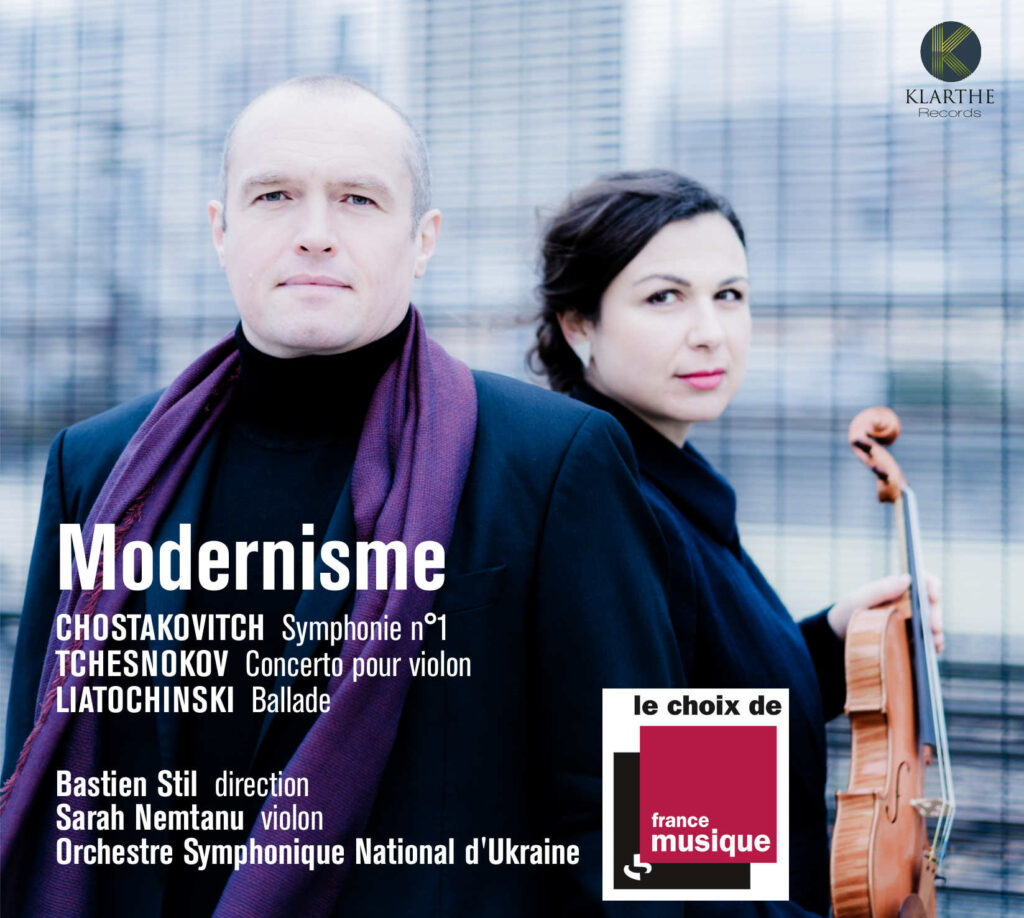At the forefront of original and participatory projects, the publisher Klarthe publishes a masterly program, the result of a call for donations made on dedicated platforms; the promise is fulfilled: the achievement is indisputable and immerses us in this modernity proper to the 1920s when the USSR opens to European modernity (hence the title “Modernism”), thanks to strong temperaments : Shostakovich (Symphony No. 1, 1926), the less famous Boris Lyatoshinsky (Ballad for piano op. 24 in 1929); both scores are put in perspective with the contemporary Ukrainian composer, Dmitri Chesnokov whose violinist Sarah Nemtanu creates here the very dense and eclectic, Violin Concerto op. 87.
In his Ballade, Boris Liatochinski (1895-1968) writes a masterly synthesis of the over-expressive post-Romanticism between Scriabin, Stravinsky and Bartok. In a loop that opens and closes on the same low, even mournful ostinato, the piece abounds in accents (a feverish and imperious dance in the second sequence), the fruit of an experimental eclecticism; exalted by a refined orchestration, it even sparkles in the dark, finely transcribed here by Dimitri Tchesnokov, in a demonic Fantasy with tenebrous resonances. The work gradually diffuses a permanent anxiety, a free, hypnotic strangeness of a lost or doomed world. This is an obvious resonance with Shostakovich’s Symphony, played in the last part.
Born in 1982, the Ukrainian Dimitri Tchesnokov assumes the western influences of Liatochinski, Schnittke, Pekka-Salonen and John Adams! He has also worked in France with Guillaume Connesson. The Concerto, commissioned by the conductor Bastien Stil, is certainly emblematic of his eclecticism yet powerful and personal, very narrative; the work follows 3 movements rather characterized: Largo where the viola’s solo line stands out in freedom, in a free, tense (sumptuous lines in the treble), drunken path, punctuated by long, stretched orchestral clusters, with a dramatic breath; linking light and nervous dance, then final march.
The central section (Intermezzo) resurrects the nocturnal enchantments like the reverie of a solitary walker: the composer’s taste for fine and refined orchestration (chattering and salient woodwinds) is affirmed, as well as rapid changes of climate, since the soloist soon carries the entire orchestra into a more swaggering, intoxicated, exalted, interrupted journey, whose verve announces the last movement: Finale ” la Ronde “, the shortest of the 3 movements, it is a nervous and agile scherzo led by the almost electrified eloquence of the violin whose discourse intensifies, sets itself on fire; enlivened by a quasi-rhapsodic line, that is to say free, with sharp virtuoso strokes and then long stretched phrases which summon a final, modest retreat…which concludes the piece in a whisper.
It takes all of Sarah Nemtanu’s inner excess, her very rich palette of nuances, in the tenuous pianos, the exacerbated jerks, to understand the dramatic and never superficial versatility, to bring out the meaning of a virtuosity turned towards the inner emergency.
The diversity of the episodes, the care in the instrumental characterization in particular in the orchestral fabric could envisage a loss of balance and global coherence; nothing of the kind, because from the beginning to the end, a tragic, sometimes threatening and deafening goings-on emerges, which provides the foundation and the architecture.

The conductor Bastien Stil underlines in the Symphony No. 1 of a Shostakovich (1906-1975) aged … 19 years, what composes its deep unity and its coherence through the four movements linked. The author has already mastered his language, one of the most ambivalent, both intoxicated (the waltz in the first movement) and sarcastic, tender and ironic. To the already troubled, questioning laughter of the Allegretto, falsely amused or even facetious, answers the Allegro in scherzo form, grating or even parodic. The density and thickness are further reinforced in the Lento, heavy and mysterious (oboe then flute, tense, distant but “worried”) where the sometimes imperceptible but lasting line of the trumpet is colored: the tragic fabric that envelops all of the composer’s scores unfolds. Seized between a calm facade and a more tenuous anguish. Conductor and orchestra give the measure of this intermediate state, which could be uncomfortable, but which installs a powerful, equivocal and strangely grandiose breath. Here is the true and most authentic Shostakovich, who asserts himself here with a mastery of sound and a sense of construction… remarkable.
As in Ravel’s work, the jolting, versatile energy of the Finale is carried away in a final, unbridled jubilation (delirious piano, and all the orchestras as if exalted, drunk… The texture, the architecture, the thickness of this Finale, of a staggering maturity in view of the author’s youth, are detailed and embodied with a passionate sincerity and understanding. The conductor and the instrumentalists of the National Symphony Orchestra of Ukraine deliver all the intensity until the limits of the timbres (woodwinds and strings), in the final tutti, also, at the top of the ambivalence (apotheosis and end, or syncopation and interruption?) Everything is there in this unresolved mystery of a dotted ending.
Ernst Van Bek